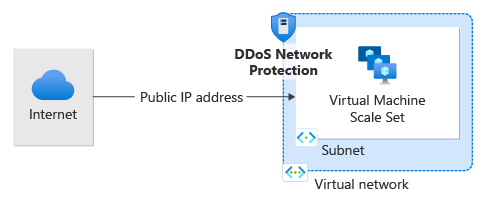Note
Access to this page requires authorization. You can try signing in or changing directories.
Access to this page requires authorization. You can try changing directories.
This QuickStart describes how to use Terraform to create and enable a distributed denial of service (DDoS) protection plan and Azure virtual network. An Azure DDoS Network Protection plan defines a set of virtual networks that have DDoS protection enabled across subscriptions. You can configure one DDoS protection plan for your organization and link virtual networks from multiple subscriptions to the same plan.
Terraform enables the definition, preview, and deployment of cloud infrastructure. Using Terraform, you create configuration files using HCL syntax. The HCL syntax allows you to specify the cloud provider - such as Azure - and the elements that make up your cloud infrastructure. After you create your configuration files, you create an execution plan that allows you to preview your infrastructure changes before they're deployed. Once you verify the changes, you apply the execution plan to deploy the infrastructure.
In this article, you learn how to:
- Create a random value for the Azure resource group name using random_pet
- Create an Azure resource group using azurerm_resource_group
- Create a random value for the virtual network name using random_string
- Create an Azure DDoS protection plan using azurerm_network_ddos_protection_plan
- Create an Azure virtual network using azurerm_virtual_network
Prerequisites
Implement the Terraform code
Note
The sample code for this article is located in the Azure Terraform GitHub repo. You can view the log file containing the test results from current and previous versions of Terraform.
See more articles and sample code showing how to use Terraform to manage Azure resources
Create a directory in which to test and run the sample Terraform code and make it the current directory.
Create a file named
providers.tfand insert the following code:terraform { required_version = ">=1.0" required_providers { azurerm = { source = "hashicorp/azurerm" version = "~>3.0" } random = { source = "hashicorp/random" version = "~>3.0" } } } provider "azurerm" { features {} }Create a file named
main.tfand insert the following code:resource "random_pet" "rg_name" { prefix = var.resource_group_name_prefix } resource "azurerm_resource_group" "rg" { name = random_pet.rg_name.id location = var.resource_group_location } resource "random_string" "ddos_protection_plan" { length = 13 upper = false numeric = false special = false } resource "azurerm_network_ddos_protection_plan" "ddos" { name = random_string.ddos_protection_plan.result resource_group_name = azurerm_resource_group.rg.name location = azurerm_resource_group.rg.location } resource "random_string" "virtual_network_name" { length = 13 upper = false numeric = false special = false } resource "azurerm_virtual_network" "vnet" { name = random_string.virtual_network_name.result resource_group_name = azurerm_resource_group.rg.name location = azurerm_resource_group.rg.location address_space = [var.vnet_address_prefix] subnet { name = "default" address_prefix = var.subnet_prefix } ddos_protection_plan { id = azurerm_network_ddos_protection_plan.ddos.id enable = var.ddos_protection_plan_enabled } }Create a file named
variables.tfand insert the following code:variable "resource_group_location" { type = string description = "Location for all resources." default = "eastus" } variable "resource_group_name_prefix" { type = string description = "Prefix of the resource group name that's combined with a random ID so name is unique in your Azure subscription." default = "rg" } variable "vnet_address_prefix" { type = string description = "Specify the virtual network address prefix" default = "172.17.0.0/16" } variable "subnet_prefix" { type = string description = "Specify the virtual network subnet prefix" default = "172.17.0.0/24" } variable "ddos_protection_plan_enabled" { type = bool description = "Enable DDoS protection plan." default = true }Create a file named
outputs.tfand insert the following code:output "resource_group_name" { value = azurerm_resource_group.rg.name } output "ddos_protection_plan_name" { value = azurerm_network_ddos_protection_plan.ddos.name } output "virtual_network_name" { value = azurerm_virtual_network.vnet.name }
Initialize Terraform
Run terraform init to initialize the Terraform deployment. This command downloads the Azure provider required to manage your Azure resources.
terraform init -upgrade
Key points:
- The
-upgradeparameter upgrades the necessary provider plugins to the newest version that complies with the configuration's version constraints.
Create a Terraform execution plan
Run terraform plan to create an execution plan.
terraform plan -out main.tfplan
Key points:
- The
terraform plancommand creates an execution plan, but doesn't execute it. Instead, it determines what actions are necessary to create the configuration specified in your configuration files. This pattern allows you to verify whether the execution plan matches your expectations before making any changes to actual resources. - The optional
-outparameter allows you to specify an output file for the plan. Using the-outparameter ensures that the plan you reviewed is exactly what is applied.
Apply a Terraform execution plan
Run terraform apply to apply the execution plan to your cloud infrastructure.
terraform apply main.tfplan
Key points:
- The example
terraform applycommand assumes you previously ranterraform plan -out main.tfplan. - If you specified a different filename for the
-outparameter, use that same filename in the call toterraform apply. - If you didn't use the
-outparameter, callterraform applywithout any parameters.
Verify the results
Get the Azure resource group name.
resource_group_name=$(terraform output -raw resource_group_name)Get the DDoS protection plan name.
ddos_protection_plan_name=$(terraform output -raw ddos_protection_plan_name)Run az network ddos-protection show to display information about the new DDoS protection plan.
az network ddos-protection show \ --resource-group $resource_group_name \ --name $ddos_protection_plan_name
Clean up resources
When you no longer need the resources created via Terraform, do the following steps:
Run terraform plan and specify the
destroyflag.terraform plan -destroy -out main.destroy.tfplanKey points:
- The
terraform plancommand creates an execution plan, but doesn't execute it. Instead, it determines what actions are necessary to create the configuration specified in your configuration files. This pattern allows you to verify whether the execution plan matches your expectations before making any changes to actual resources. - The optional
-outparameter allows you to specify an output file for the plan. Using the-outparameter ensures that the plan you reviewed is exactly what is applied.
- The
Run terraform apply to apply the execution plan.
terraform apply main.destroy.tfplan
Troubleshoot Terraform on Azure
Troubleshoot common problems when using Terraform on Azure
